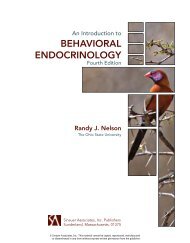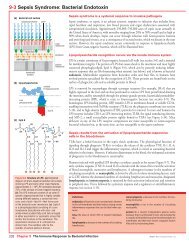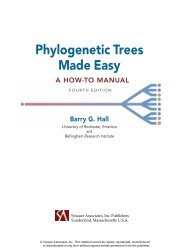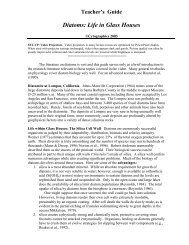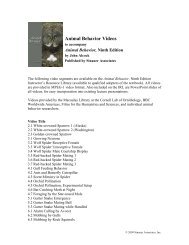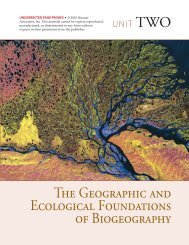A Primer of Conservation Biology, Fifth Edition - Sinauer Associates
A Primer of Conservation Biology, Fifth Edition - Sinauer Associates
A Primer of Conservation Biology, Fifth Edition - Sinauer Associates
You also want an ePaper? Increase the reach of your titles
YUMPU automatically turns print PDFs into web optimized ePapers that Google loves.
A <strong>Primer</strong> <strong>of</strong><strong>Conservation</strong> <strong>Biology</strong>FIFTH EDITIONRichard B. PrimackBoston University<strong>Sinauer</strong> <strong>Associates</strong>, Inc. PublishersSunderland, MA U.S.A.© 2012 <strong>Sinauer</strong> <strong>Associates</strong>, Inc. This material cannot be copied, reproduced, manufactured ordisseminated in any form without express written permission from the publisher.
ContentsChapter 1Defining Coservation <strong>Biology</strong> 3The New Science <strong>of</strong> <strong>Conservation</strong> <strong>Biology</strong> 4The philosophical roots <strong>of</strong> conservation biology 7<strong>Conservation</strong> biology’s international scope 9The interdisciplinary approach: A case study withsea turtles 10<strong>Conservation</strong> <strong>Biology</strong>’s Ethical Principles 13Achievements and Challenges 15Summary 16Chapter 2What is Biodiversity? 19Species Diversity 21What is a species? 21Measuring species diversity 24Genetic Diversity 25Ecosystem Diversity 27Species interactions 28Food chains and food webs 32Keystone species and resources 32Ecosystem dynamics 34Biodiversity Worldwide 35How many species exist? 35Where is the world’s biodiversity found? 38The distribution <strong>of</strong> species 41Summary 43© 2012 <strong>Sinauer</strong> <strong>Associates</strong>, Inc. This material cannot be copied, reproduced, manufactured ordisseminated in any form without express written permission from the publisher.
Contents viiChapter 3The Value <strong>of</strong> Biodiversity 47Ecological Economics and EnvironmentalEconomics 49Direct Economic Values 52Consumptive use value 53Productive use value 54Indirect Economic Values 56Ecosystem productivity 57Water and soil protection 59Climate regulation 61Species relationships and environmental monitors 61Amenity value 63Educational and scientific value 64Multiple uses <strong>of</strong> a single resource: A case study 66The Long-Term View: Option Value 66Existence Value 69Environmental Ethics 72Ethical arguments supporting preservation 72Deep ecology 75Summary 76Chapter 4Threats to Biodiversity 79Human Population Growth and Its Impact 80Habitat Destruction 83Threatened rain forests 85Other threatened habitats 88Habitat Fragmentation 92Threats posed by fragmentation 94Edge effects 95Environmental Degradation and Pollution 98Pesticide pollution 99Water pollution 100© 2012 <strong>Sinauer</strong> <strong>Associates</strong>, Inc. This material cannot be copied, reproduced, manufactured ordisseminated in any form without express written permission from the publisher.
viii ContentsAir pollution 103Global Climate Change 104Warmer waters, acidification, and rising sea levels 108The overall effect <strong>of</strong> global warming 109Overexploitation 110International wildlife trade 112Commercial harvesting 114Invasive Species 116Invasive species on islands 119Invasive species in aquatic habitats 120The ability <strong>of</strong> species to become invasive 122Control <strong>of</strong> invasive species 123Genetically modified organisms 125Disease 126A Concluding Remark 129Summary 130Chapter 5Extinction is Forever 135The Meaning <strong>of</strong> “Extinct” 137Rates <strong>of</strong> Extinction 138Extinction rates in aquatic environments 141Extinction rates on islands 141Island biogeography and extinction rate predictions 142Local extinctions 144Vulnerability to Extinction 146Problems <strong>of</strong> Small Populations 150Minimum viable population (MVP) 150Loss <strong>of</strong> genetic variation 153Effective population size 158Demographic and environmental stochasticity 161The extinction vortex 165Summary 166© 2012 <strong>Sinauer</strong> <strong>Associates</strong>, Inc. This material cannot be copied, reproduced, manufactured ordisseminated in any form without express written permission from the publisher.
Contents ixChapter 6Conserving Populations and Species 169Applied Population <strong>Biology</strong> 170Methods for studying populations 171Monitoring populations 172Population viability analysis 176Metapopulations 178<strong>Conservation</strong> Categories 180Legal Protection <strong>of</strong> Species 184National laws 184The U.S. Endangered Species Act 185International agreements 188Establishing New Populations 191Considerations for animal programs 193New plant populations 196The status <strong>of</strong> new populations 198Ex Situ <strong>Conservation</strong> Strategies 199Zoos 200Aquariums 205Botanical gardens 206Seed banks 208Summary 210Chapter 7Protected Areas 213Establishment and Classification <strong>of</strong> ProtectedAreas 214Marine protected areas 217The effectiveness <strong>of</strong> protected areas 217Prioritization: What should be protected? 219Measuring effectiveness: Gap analysis 226Designing Protected Areas 229Protected area size and characteristics 230Networks <strong>of</strong> protected areas 234© 2012 <strong>Sinauer</strong> <strong>Associates</strong>, Inc. This material cannot be copied, reproduced, manufactured ordisseminated in any form without express written permission from the publisher.
x ContentsLandscape Ecology 238Managing Protected Areas 239Managing sites 242Monitoring sites 244Management and people 246Zoning as a solution to conflicting demands 246Challenges to Park Management 249Summary 250Chapter 8<strong>Conservation</strong> Outside ProtectedAreas 255Unprotected Public and Private Lands 256Human-dominated landscapes 257Ecosystem Management 260Working with Local People 263In situ agricultural conservation 266Extractive reserves 266Community-based initiatives 267Payments for ecosystem services 268Evaluating conservation initiatives 269Restoring Damaged Ecosystems 270Approaches to ecosystem restoration 274Targets <strong>of</strong> major restoration efforts 275The future <strong>of</strong> restoration ecology 278Summary 280© 2012 <strong>Sinauer</strong> <strong>Associates</strong>, Inc. This material cannot be copied, reproduced, manufactured ordisseminated in any form without express written permission from the publisher.
Contents xiChapter 9The Challenge <strong>of</strong> SustainableDevelopment 283Sustainable Development at the Local Level 285Local and regional conservation regulations 286Land trusts 286Enforcement and public benefits 289<strong>Conservation</strong> at the National Level 290International Approaches to SustainableDevelopment 292International conservation agreements 293International summits 296Funding for <strong>Conservation</strong> 297The World Bank and international NGOs 298Environmental trust funds 300Debt-for-nature swaps 300How effective is conservation funding? 301<strong>Conservation</strong> Education 303The Role <strong>of</strong> <strong>Conservation</strong> Biologists 305Summary 308Appendix: Selected Environmental Organizationsand Sources <strong>of</strong> Information 311Glossary 315Chapter Opening Photograph Credits 325Bibliography 327Index 353About the Author 365© 2012 <strong>Sinauer</strong> <strong>Associates</strong>, Inc. This material cannot be copied, reproduced, manufactured ordisseminated in any form without express written permission from the publisher.




